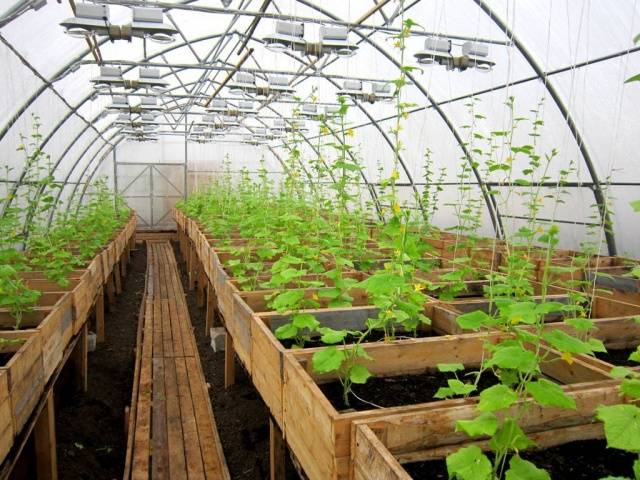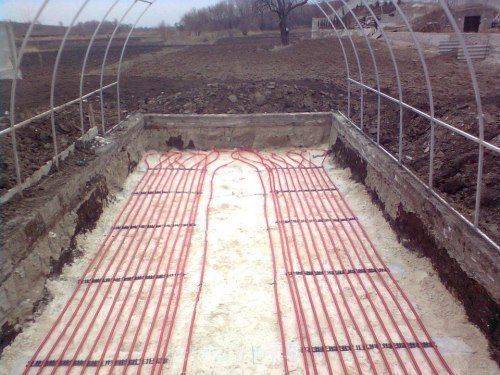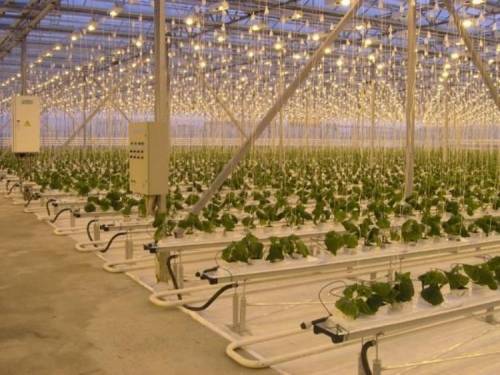A greenhouse for growing cucumbers all year round is a stationary room in which optimal conditions for the growth and fruiting of this thermophilic popular vegetable must be maintained. Ordinary summer cottages are poorly suited to protect cucumbers from winter frosts and autumn-spring slush. They are good only in summer and early in the fall... To get a good harvest of cucumbers in the greenhouse all year round, it is necessary to provide the vegetables with the most comfortable conditions:
- temperature regime;
- the level of soil and air moisture;
- ventilation;
- good illumination;
- timely watering;
- high-quality feeding and care of shoots.
Growing cucumbers in a greenhouse all year round is very costly, the costs can be recouped only with large volumes of vegetables intended for sale. There are many requirements for a greenhouse used all year round.
The best material for a greenhouse is polycarbonate. Plates made of this material perfectly transmit light, provide sufficient air circulation and serve as a good heat insulator. It is most convenient to assemble a polycarbonate structure on a metal frame. It is built from pipes, on which it is easy to make fastenings for future walls. Before this, the metal structure must be painted to protect the material from rust, because the cultivation of cucumbers involves high humidity during the entire growth period.
Greenhouse heating
Cucumbers are thermophilic plants that do not grow in low light and low temperatures. It is possible to plant seeds or seedlings in the soil only when the soil temperature is not lower than + 12 ° С, and the air temperature should be maintained at + 20 ... + 25 ° С during the entire life cycle of the plant. In summer and early autumn, vegetables grow well in the open field or in a greenhouse covered with ordinary plastic wrap.
But in order to grow cucumbers all year round, it is necessary to supply the greenhouse with additional heat sources. The easiest way is to install a stove in the center of the building, which is heated with coal or wood. But this method of heating requires constant monitoring, since firewood and coal quickly burn out and do not keep heat for long.
An alternative way is to build a special furnace that uses sawdust. Sawdust burns out completely for a longer time than firewood, and the temperature after their complete combustion lasts up to 10 hours. This is enough to heat the greenhouse at night.
The most reliable and expensive option is to create a separate boiler room, the pipes of which will connect the greenhouse with a boiler that heats water. The fuel in this case is liquid, solid or gas, and the heat source is water vapor, which flows along the perimeter of the greenhouse and maintains the temperature regime at the required level around the clock. But this heating method is extremely expensive, so it is only suitable for large industrial greenhouses supplying vegetables to large wholesale centers and shops.
Greenhouse lighting
Polycarbonate materials transmit sunlight well, but in the winter season, the daylight hours are much shorter. And cucumbers need bright lighting for 13-14 hours a day. Therefore, growing these vegetables in a greenhouse all year round will not do without additional light sources. For this, various methods are used:
- Special lampsintended for greenhouse plants.Their advantages are that they are best suited to support the process of photosynthesis in plant leaves and are inexpensive, and the disadvantage is the difficulty of installing such devices.
- Energy saving mercury lamps provide a sufficient amount of light, but serve for a relatively short time and create difficulties in disposal.
- Fluorescent lighting devices can also be used in a greenhouse, but they take up a lot of space and look bulky.
- LED built-in backlight looks great, but its installation is expensive.
Additional lighting in the greenhouse for growing cucumbers is one of the main conditions for obtaining a crop, so in any case, you will have to choose some option. Before installing the greenhouse, it is also worth choosing the most illuminated area, but preferably on the calm side, since drafts and temperature changes can negatively affect growing vegetables.
Soil treatment
Front the formation cucumber beds you need to prepare the ground. First, remove the top layer 5-10 cm thick to get rid of parts of other plants and possible pests. Then the land is treated with bleach or copper sulfate. This is necessary for the final extermination of harmful microorganisms that are in the soil.
The cleaned soil is fertilized with various minerals containing nitrogen, potassium, phosphorus. It is more convenient to use ready-made fertilizers designed specifically for growing cucumbers. In some cases, the soil is additionally fed with manure and poultry manure, but in a large greenhouse, using industrially produced fertilizers will be the best option. If cucumber seeds were planted in the greenhouse, then the first shoots will have to wait for several days.
With the seedling method of cultivation, after processing the soil, beds up to 30 cm high and a distance of up to half a meter between them are formed. In the beds, you need to make holes, keeping a distance of up to 30-40 cm. This is necessary so that future cucumber bushes do not interfere with each other.
Before planting seedlings, the hole is watered with water, a weak solution of manganese or saltpeter, which will disinfect the soil again and create a nutrient medium for young and weak roots. Then the seedlings are placed in the recess and sprinkled with a dense layer of soil.
Greenhouse cucumber care
Already at the planting stage, it is necessary to provide trellises to which long shoots of vegetables will be tied. They are pinched at a length of 50 cm, creating a multi-layered bush: the lower side and middle shoots must be tied over the first leaf, the upper ones - over the second. All secondary stems with dead ovaries and dry leaves must be removed immediately, otherwise they will interfere with the formation of fruits.
Large year-round greenhouses are usually equipped with automatic irrigation system... This is an expensive technology, but it saves time. If there is no opportunity to purchase and install automation, you can get by with traditional manual watering. You just need to make sure that the water is not cold, especially in winter, when the temperature of the air and soil is already difficult to maintain at the proper level.
The air humidity in the greenhouse should be about 90%, and the soil moisture should be 50%. But the ventilation system is also necessary without fail, because high humidity and relatively low air and soil temperatures can lead to the appearance of gray rot, which can destroy the entire crop.
In the cold season, cucumbers especially need additional sources of nutrients. A water-soluble fertilizer that is sprayed on the leaves is effective against this problem. There are a large number of such products on the market, designed specifically for growing cucumbers in a greenhouse all year round.
Even if all the conditions for the growth of vegetables are created in the greenhouse, it is more correct to choose hybrid varieties that are less sensitive to frost, moisture changes, artificial lighting and other unfavorable factors that arise in late autumn and winter.
A feature of these types of cucumbers is not only their resistance to difficult conditions, but also the speed of fruit ripening, which will allow you to collect a rich harvest throughout the year.












